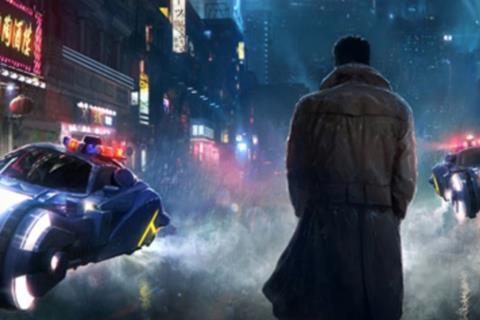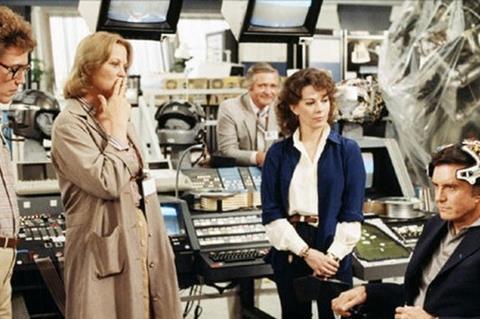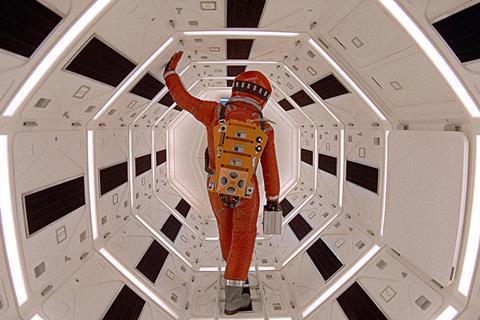The VFX wizard behind movies like 2001: A Space Odyssey and Blade Runner, Douglas Trumbull has spent the last decade developing Magi, which can capture and show films at high resolution and high frame rates – and deliver the immersive experience he says cinema audiences are looking for.
“I think I’ve cracked the code for the next step in cinema,” Douglas Trumbull says. “When you see the movies that I am doing you will see the closest thing to a living hologram. The surface of the screen virtually vanishes so you’re looking into a volumetric space. I’ve been trialling and testing this for ten years and I know it works. Now I’m trying to get the attention of people in the industry and show them the next big leap for cinema.”

From anyone else this may seem like so much fanciful thinking but Trumbull is a visionary who has already seen, invented and built the future of cinema several times over.
He is the visual effects wizard behind three of the most influential science-fiction movies of all time: 2001: A Space Odyssey (1968), Close Encounters of the Third Kind (1977) and Blade Runner (1982).
He is the inventor of Showscan a hypervivid film process that showcased the startling impact of high frame rates four decades before Peter Jackson brought it into fashion with The Hobbit. After merging his company with a division of IMAX in 1994 he took the company public in a move that brought the giant screen format from niche to mainstream; and in 1972 he directed Silent Running with an ecological disaster theme which seems more prescient with each year.
Yet it is a fascination with the challenges of making and displaying movies using advanced production technologies, to which the 76-year old has devoted most of his career.
“TV is saturated with really good storytellers,” he tells IBC365. “I am trying to create an immersive experience which tells a good story both visually and acoustically but way, way beyond the capability of a TV set.”
Trumbull believes that films shot at ultra-high resolution and frame rates (and supported by equally rich soundtracks) will deliver a kind of immersive experience that will draw more people to movie theatres.
He has spent the last decade developing Magi, a complete production and exhibition system capable of showing films in 2D and 3D at 60 fps and 120 fps.
It includes a “revolutionary” 120 fps 4K 3D camera that uses a single lens and a single sensor and a virtual production methodology which Trumbull used to produce and direct sci-fi short, UFOTOG – a film he presented in person at IBC2014. He has since made other demo projects in the format.
“I firmly believe that the production values of films are not being adequately captured or projected, as a result of antiquated film standards of 24 fps and 2K resolution,” he says. “The images we see today on cinema screens are not as good as film prints dating back to 35mm Technicolor in the 1930s. Nor are images seen today as good as the great 70mm cinema epics.”
He claims that even director Stanley Kubrick felt “very frustrated” by having to shoot 24 fps on the 70mm production of 2001.
Magi’s technical parameters are designed to eliminate the blurring and strobing which are inherent to conventional film projection but the results are more nuanced than viewers might associate with high frame rate releases like Ang Lee’s Billy Lynn’s Long Half Time Walk.
Preserving the vital ‘film look’ is central to Magi’s core patents.
“I firmly believe that the production values of films are not being adequately captured or projected, as a result of antiquated film standards of 24 fps and 2K resolution.”
A kind of Magi
“A ‘television look’ is not desirable,” Trumbull explains. “Viewers associate high frame rates, high brightness, and lack of flicker with the look of television. Viewers also associate lower frame rates, lower brightness, and unperceived flicker with dramatic films.
“I have discovered (and patented) how to multiply the frame rate of movies from 24 to 60, 120, 144, or more, but three vitally important factors must remain in order for the image to be perceived as a dramatic film-like experience.”
He says that the image brightness must remain similar to the films seen in darkened theatres for the past 90 years [at about 14 foot lamberts]. That the flickering associated with movie projection must be retained and that film screen size and field of view must be far greater than that of a TV screen.
“These can be easily achieved and are the core invention of Magi,” he says.
He has also patented the ability to dynamically change the frame rate on any pixel, object, person, shot, or sequence in a film for dramatic effect. He says this could be an important way to control vividness and persistence of vision “so that the ultra-high frame rate would not intrude on suspension of disbelief.”
“The difference between cinema as we have known it for last hundred years and today’s projection (and TV) is that digital projectors have no shutter. I’ve made extensive tests which prove that by re-introducing a shutter, digitally, into existing cinema equipment, you can retain the cinematic look at almost any frame rate. It’s a fundamentally new concept which most cinematographers and studios are not aware of.”
He says the Magi process will make 3D production inexpensive (by being made alongside 2D versions), while providing filmmakers with the convenience of a single, small camera.
“Ultimately, Billy Lynn was released using standard DCPs at 24 fps, and at standard brightness, and neither Sony Pictures nor Ang Lee were responsive to my suggestion that the Magi DCP could contain 120 fps 3D for use in tens of thousands of cinemas,” he says.
Trumbull has put a lot of his own money into the system and is “aggressively” promoting it. He is organising a “roadshow” in which he will take a version of the Magi-Pod, a pre-fabricated auditorium, to directors, studios, exhibitors and investors.
He hopes to gather enough industry support to form a group which will subsidise its installation into theatres.
Maverick at heart
He is trying to do all this outside of the studio system, having turned his back on Hollywood in 1983 after he says Hollywood turned its back on him.
“I left the movie industry as director shortly after Natalie Wood died,” he explains.

The actress drowned while off-set during the production of Brainstorm, Trumbull’s second directorial feature intended as a showcase for Showscan’s 60 fps 70mm process. MGM pulled the plug, although Trumbull managed to complete the film using 35mm 24 fps and it was given a limited release.
“That was my worst professional experience,” he says. “The way the studios acted after her death was completely reprehensible, demoralising, dispiriting. No-one knows the tragic circumstances of her death and I don’t either but I knew I couldn’t rely on studios to back me up. I had to rely on myself.”
He relocated to the East coast, setting up Trumbull Studios in Massachusetts where he continued to push the boundaries of giant screen, high frame-rate, extreme brightness 3D and virtual digital production.
“It is tremendously hard trying to break down the doors or get studios to embrace a new standard,” he admits.
While streaming services are causing a decline in movie going, he argues there’s a lack of concern in Hollywood for re-energising the big screen epic.
“The studios don’t care that much. Every dollar they lose in theatrical they make up for by selling their film as a commodity product in a commodity market to which people subscribe. They don’t see themselves as being the pioneers of new immersive technology.”
Trumbull is now trying a different tack, one which de-emphasises the tech and targets the possibilities of storytelling. That means reaching out to directors the calibre of Ang Lee (currently making The Gemini Man in 3D 120 fps), James Cameron (shooting the Avatar sequels at an unannounced frame rate), Ridley Scott and Peter Jackson.
“Almost all of those [directors] I know are eager for an improved motion picture experience. They can tell studios what they want to do.”
Christopher Nolan, whose own Interstellar pays homage to 2001, is first on Trumbull’s list.
“He is a big advocate of cinema as spectacle but wants more portable, lightweight and unobtrusive cameras,” he says.
2001: Journey To The Stars
Trumbull describes himself as a “writer-producer-director-engineer-inventor” who took one half of his talent from his mother, an artist, and the other from his father, who had rigged special effects for The Wizard of Oz (1939) later becoming part of the crew on Star Wars.
He first toyed with becoming an architect and studied illustration but his long-standing interest in science fiction got the better of him and instead of buildings he gravitated to photoreal pictures of aliens and spaceships.

That led him to Graphics Films in LA, a specialist outfit making films for NASA for which Trumbull created animations and paintings as part of the embryonic mission to the moon Apollo programme. But it was a fictional short called To The Moon and Beyond, which Trumbull had designed for the 1964 World’s Fair in New York, which changed his life.
It wasn’t just the abstract interpretation of the subject which captured the imagination of Stanley Kubrick. The short was made in Cinerama 360, a process which projected 70mm fisheye photography on to a domed screen.
Kubrick hired the 23-year old for nine months to work on his own project, at Borehamwood and Elstree outside London, provisionally called Journey To The Stars.
2001: A Space Odyssey consumed the next two and a half years but Trumbull couldn’t have hoped for a greater launchpad. The movie, now half a century old, sealed Trumbull’s place in film lore and remains his proudest achievement.
“It is Kubrick’s movie not my movie,” Trumbull emphasises. He has previously criticised the director’s decision to collect the 1969 Academy Award for Best Visual Effects (Kubrick’s only Oscar win) while Trumbull himself was credited as one of four special photographic effects supervisors.
However, this doesn’t seem to bother him now.
“Kubrick had incredible stamina, a willingness to go into the unknown and develop things for his movie that have never been seen before. I admire that. It was a unique experience to have all of that freedom to experiment and to fail to come up with something ground-breaking like Stargate.”
His tasks in 2001 began with designing lunar landscapes, building and then painting miniature spaceships, but soon evolved into greater responsibility for whole sections of the film.
The most celebrated of these is the Stargate, the psychedelic hyper-drive that jumps astronaut Kier Dullea into another dimension and which the movie’s marketers eventually sold to the counter culture as the ‘Ultimate trip’.
Inspired by photo-finish cameras at horse-races, Trumbull conceived a new type of camera that had its aperture – a vertical slit - on the outside. With the Slit Scan, a giant machine nearly 20x30ft, he could take lengthy exposures of massive patterned artworks and backlit coloured gels as they were moved past the lens. A single frame of film took four minutes to produce.
“2001 had the attraction of being extremely immersive, largely non-verbal and experiential,” says Trumbull. “People eventually understood they were going to get this psycho-visual-audio experience the like of which hasn’t happened very often in the fifty years since.”
Fresh from Kubrick’s laboratory, Trumbull was hired by Italian auteur Michelangelo Antonioni to create an apocalyptic climax to his film Zabriskie Point (1970).
“I took what I’d learned on 2001 about forced perspective, long open shutters and superimposed imagery and had this idea for a night time shot of Los Angeles which would look as if the city were being carpet-bombed by huge explosions coming closer and closer to camera.”
“It is tremendously hard trying to break down the doors or get studios to embrace a new standard.”
He shot plates late at night overlooking LA from the Griffith Observatory (featured in Rebel without a Cause and La La Land) then hired a crew from MGM’s pyrotechnic department and went to an area in the California desert “where you had a permit to blow up anything you want.”
Canisters filled with phosphor, gasoline and other chemicals were promptly exploded “like thermo-nuclear war” filmed by Trumbull at 96 fps and 72 fps. He was in the process of super-imposing these onto the LA plates when Antonioni fired him.
“I was terminated. He had no idea of the orderly, optical printing process or how long it took and just got tired of waiting.”
While Antonioni went ahead and dynamited a real house (also shot at high speed for his film’s ending), Trumbull kept the filmed explosions in his archive until he found a use for them 12 years later.
“Blade Runner was made with a very low budget so when I suggested we enhance the opening sequence - and it won’t cost you a dime – Ridley [Scott, director] thought it a great idea,” recalls Trumbull. “It established this industrial chemical environment in the first few seconds of the movie.”
Trumbull has always strived for photorealism which is why he is generally disparaging of films made entirely of digital VFX.
“I feel models bring a higher degree of credibility to the screen than computer graphics yet very few models are built for films today,” he says. “Obtaining perfect photorealism is the hardest part of the whole equation. With digital the issue is always how many layers and textures you can apply before the render time for the shot goes on for so long you have to back off.”
He caveats, “That’s not to say that you can’t do amazing things with CGI. The synthetic tiger in Life of Pi, for example, is indistinguishable from the real thing. It’s beautiful and something you could never do with puppets and prosthetics. Also, digital composition with blue and green screen is far superior to using an optical printer.
“But when you allow yourself the latitude to experiment using miniatures or a water tank or chemicals, fluids or natural lighting there will something wonderfully unexpected.”

He did this for the 22-minute birth of creation sequence in Terrence Malick’s Tree of Life (2011), using fluorescent dyes, paints, flares, CO2, even milk to devise eye-popping images that were often accidental.
“I like to be open to the surprises you get which you could never write an algorithm or computer code for,” he says. “That to me is the allure of shooting organically - it keeps things fresh.”
Models and front projection were a feature of Silent Running which he produced and directed (from a screenplay co-written by Michael Cimino who would later make The Deer Hunter). “I was trying to make the antithesis of the cold and intellectual 2001 where the most human thing in the movie was the computer,” he says.
In 1979 he was Oscar nominated for Star Trek: The Motion Picture, losing out to H.R Giger’s handywork for Alien.
Back to the future
It was the incredible success of Back to the Future – the first entertainment simulator ride – for which Trumbull holds a patent, that convinced him of the huge business opportunity “making the ultimate virtual reality experience.”
The four-minute film played for 16 years from 1990 in three venues and made $1.2 billion for Universal.
”It is now the largest IMAX-style screens [Premium Large Format in industry jargon] making the lion’s share of revenue for exhibitors. This also shows us that audiences have an appetite to see a movie in a theatre rather than wait for it on Netflix. They want an epic immersive, more participatory experience.”
It’s one reason why he believes, “All the stars are lined up” in his favour.
I’m hoping to get back to delivering the movie of my dreams combined with the technology of my dreams because no one else is doing this.”
He has just completed a new version of a screenplay for a feature length sci-fi which he hopes to make and display using Magi.
“I’ve been going through a learning curve to understand the safest way to make a big leap in cinema that is not going to be met with rejection,” he says. “Finally, I have a script that is synchronised with the technology I’ve been developing.”
Ultimately, he feels that the light emitting walls just being introduced to cinemas will replace projection.
“OLED especially can be far superior to projection - although at this point it is very expensive to manufacture,” he says. “In the future, people will acclimatise to high frame rates. Right now, they equate very brightness and high frame rates with TV. It’s taken me ten years but I think I figured it out how to make the breakthrough - then there is going to be no stopping this thing.”
He signs off, “I love exploring new kinds of immersive cinematic experience - one that is highly visual, spectacular and not melodramatic. That is where I am headed.”



























No comments yet